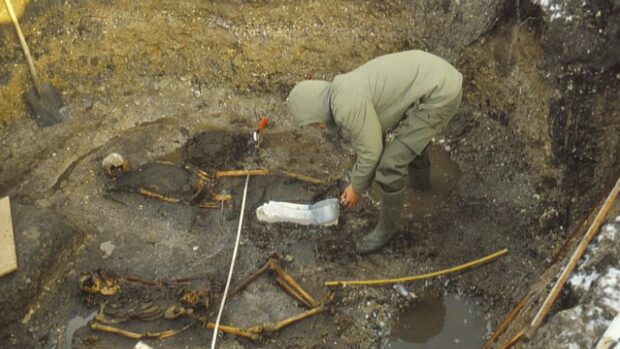Viking Grave in Denmark Holds Remains of Mother and Son
The Copenhagen Post reports that researchers at the Roskilde Museum have analyzed DNA samples from the remains of a man and woman discovered in a 1,000-year-old burial known as the Gerdrup Grave, and determined that the pair were mother and son.
The grave contains the skeletons of a child and a woman, and archaeologists have long speculated who they might be and why they were buried together.
Another element of the mystery is that the child was killed at some point and buried next to the woman.
The Gerdrup Grave has another important aspect to it: it was the first discovery that proved that Viking women were buried along with a weapon – in this case, a lance.
Familial link
Well, now some new information has surfaced about the longstanding mystery. DNA testing has revealed that the pair are actually mother and son and, as previously believed, a sacrificial slave.
“It’s an incredibly exciting and surprising result we have here. We need to thoroughly consider what this means,” Ole Kastholm, an archaeologist and senior curator at Roskilde Museum, told TV2 Lorry.
The revelation means that the history of the Gerdrup Grave needs to be rewritten and that a new mystery needs to be solved.
“We need to look at whether other graves and other source material from the Viking Age could reveal some patterns that might help us solve this case,” said Kastholm.
Do Sagas hold the key?
The key to solving the enigma could be found in one of the old Icelandic Sagas, a series of narratives written between the 12th and 15th centuries covering Viking history.
The man in the grave looks to have been executed, hung, and bound before being laid in the grave. Meanwhile, the woman was weighed down with large stones.
One theory is that the lance belonging to the woman in the grave is actually a sorceress’s staff.
Something Odd about them?
One of the sagas tells the story of the sorceress Katla and her son Odd who were persecuted and executed. Odd was hung and Katla was stoned to death.
While the plot thickens and archaeologists work to solve the latest part of the puzzle, the skeletons can be viewed at Roskilde Museum.


